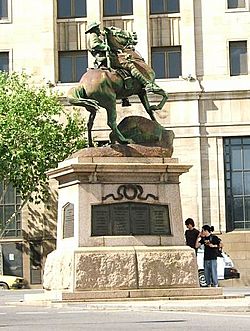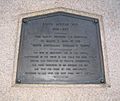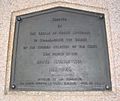South African War Memorial (South Australia) facts for kids
The South African War Memorial is a special statue in Adelaide, Australia. It is also known as the Boer War Memorial. This memorial honors the brave soldiers from South Australia who fought in the Second Boer War. This war happened between 1899 and 1902.
It was the first time South Australian soldiers went to fight in a war overseas. About 1,531 men and over 1,500 horses were sent to the war. Sadly, more than 59 South Australians lost their lives.
The memorial is a statue of a soldier on a horse, called an equestrian statue. You can find it in front of Government House in Adelaide. This is a very important building in the city. The memorial is at the corner of North Terrace and King William Road.
People raised money to build the memorial. A sculptor from London, Adrian Jones, designed it. The statue does not show a real soldier. However, some people think the rider's face looks like a soldier named George Henry Goodall.
The Governor of South Australia, George Le Hunte, officially showed the memorial to the public on June 6, 1904. Today, it is a key spot for the Anzac Day marches. It is also seen as one of Adelaide's most important statues. Because of its history, it was added to the national heritage list in 1990.
Contents
Why Was the Memorial Built?
The Boer War and South Australia's Role
In 1899, two areas in South Africa, the Orange Free State and Transvaal, declared war on Britain. South Australia was very loyal to the British Empire at that time. Even though Australia was not yet a united country, South Australia joined other Australian colonies. They sent troops to help Britain in the war.
Newspapers in Adelaide encouraged people to support the war. Over three years, nine groups of South Australian soldiers were sent. In total, 1,531 men and 1,507 horses went to fight. The government and public donations helped pay for this effort. Some Australians also went to South Africa on their own. By the end of the war in 1902, at least 59 South Australians had died.
Designing and Building the Memorial
How the Statue Was Chosen
After the war ended, a group was formed to build a memorial. They wanted to honor those who served and died. In 1901, someone suggested building a statue of a soldier on a horse. George Brookman led this group. They quickly raised £2,500 from public donations.
The group in London helped find a sculptor. They chose Captain Adrian Jones. He was a veterinarian, a military officer, and a sculptor who loved animals. He had worked on horse statues before. Jones offered to create a smaller statue based on a sketch he made. The committee loved his idea and agreed to it.
The Soldier's Face
Adrian Jones needed advice on how Australian soldiers looked. He met George Henry Goodall, a South Australian soldier who fought in the Boer War. Goodall was in London for a special event. Jones asked Goodall to pose for him. Goodall later said that Jones made a clay model of his head.
Even though Jones's own writings do not mention this, a note from 1940 says something interesting. It mentions that a photo of Mr. Goodall from 1902 looks very much like the statue's face. Goodall said he only posed for the head. He also said he was not chosen because he was a special soldier.
The Pedestal and Names
In 1903, a competition was held in Adelaide to design the base, or pedestal, for the statue. The design by Garlick, Sibley and Wooldridge won. The pedestal is about 12 feet tall. It was made from granite stone from Murray Bridge, a nearby town.
Bronze plaques are attached to the sides of the pedestal. These plaques list the names of 59 South Australians who died in the war. These plaques were made from gun plates. Some other South Australians also died because of the war, but their names are not on the list.
The memorial stands in front of Government House. This is a very busy spot in the city.
Unveiling the Memorial
The Big Day
The memorial was officially shown to the public on June 6, 1904. This date was special for two reasons. It was the birthday of Prince George, who later became King. It was also the third anniversary of the Battle of Graspan, where South Australian soldiers fought.
A large crowd gathered to watch the event. Speakers included George Brookman, who led the memorial committee, and George Le Hunte, the Governor. The statue was covered with canvas and the Union Jack flag. Then, the covers were removed, revealing the statue.
Changing Names
When it was first unveiled, people called it the "National War Memorial." But in 1931, a new memorial was built for soldiers of World War I. So, the name of this statue was changed to the South African War Memorial.
At the time it was unveiled, this memorial was one of only two public statues in Australia that showed a person on a horse. It was the only one built to remember a war.
The Memorial Today
A Place for Remembrance
After World War I, the South African War Memorial became a key part of the Adelaide Anzac Day march. The march starts at the National War Memorial. It then goes along North Terrace and turns onto King William Road. As the marchers turn, they salute the South African War Memorial. The march ends with a service at the Cross of Sacrifice.
In 1986, for South Australia's 150th birthday, a special path called the "Jubilee 150 Walkway" was made. It starts at the memorial. On June 6, 2004, a ceremony was held to celebrate 100 years since the memorial was dedicated. The Governor, Marjorie Jackson-Nelson, was there.
Keeping It Clean
Because the memorial is on a busy street corner, it can get dirty. It has been cleaned and fixed up at least twice recently. One project cleaned the granite base. Another, more detailed restoration happened in April 2007. This project cost $90,000.
Future Plans
There has been talk about building a copy of the memorial. In 2008, a site was chosen in Anzac Parade, Canberra for a new national Boer War memorial. A committee was formed to find a design for this new memorial. They said they would even consider making a copy of the Adelaide statue if they could find the original mold.
Images for kids









